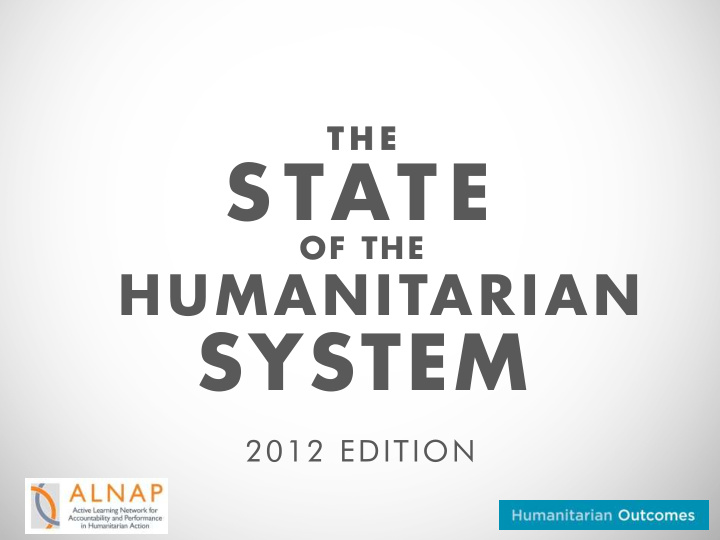



T H E S TAT E OF THE HUMANITARIAN SYSTEM 2012 EDITION
WHAT THIS REPORT COVERS Where e are we now? What’s (perceived to be) wo working ing? What at can n we expec ect?
THE BIG PICTURE
A BASELINE: measuring systemic change
The 2010 pilot report: developing the methodology and baseline Research goals • Determine the size, shape, scope and key components of the ‘humanitarian system’ • Assess the performance of the system as a whole
The 2012 SOHS report: what’s different 2010 Pilot 2012 First full report • • Descriptive statistics Descriptive statistics • • Financial analysis Financial analysis • • Evaluation synthesis Evaluation synthesis • • Interviews Interviews • • Global survey Global survey • Two field studies • Aid recipient survey • Expanded/refined methodology • Wider lens, capturing more local actors
The humanitarian ‘system’: core actors Providers Recipients Implementers Donor Host governments Red Cross/Crescent Movement, governments, Affected INGOs, NNGOs, UN agencies foundations populations
Other humanitarian actors Private sector entities / commercial Military contractors Providers Implementers Recipients Military Diaspora groups and global remittances (e.g. Zakat system)
Global humanitarian funding Continued upward trend
Humanitarian funding as percentage of global wealth
Humanitarian funding: channel trends Lion’s share still comes from DAC donors, but emerging donors, private sources and pooled funds are increasingly important 158 number of non-DAC donors as of 2010, doubled since start of decade 5x increase in private funding including corporations, foundations and individual donations 50% CERF, CHFs and other multilateral funding up in 2009-10 compared with previous 2 years
Human and financial resources Summary table of budgets and staffing of humanitarian providers, 2010 Humanitarian expenditure Humanitarian field staff NGOs $7.4 bn 141,400 UN $9.3 bn 85,681 $1.2 bn 47,157 Red Cross / Crescent Movement ($16-17b) 274,238 Source: Agency personnel, annual reports, audited financial statements, and internal agency documents
Humanitarian organisation mapping • Operational NGOs – Approximately 4,400 on the study’s live database (> 60% national) NGOList - www.humanitarianngolist.org • INGOs dominated by old guard: MSF, CRS, Oxfam, Save the Children and World Vision make up 38% of the NGO spend • Rise of the SINGOs (e.g. BRAC, Mercy Malaysia) • Host governments and regional organisations growing capacities and assertiveness
Fragmentation Convergence
OECD DAC CRITERIA Coverag verage/suff e/sufficie iciency ncy Relevance/approp vance/appropriaten iateness ess Effectiv ctiven eness ess Connected nectedness ness Effic icie iency ncy Coher erence ence
COVERAGE/SUFFICIENCY Not much has changed since the pilot… Financial need as opposed to actual numbers of affected people
WHAT WE DON’T KNOW What at happ ppen ens s when the here is is no no app ppeal eal? Ho How many pe peopl ple e are affected ected? What’s the case se lo load d of of pe peopl ple e ass ssisted? sted?
WHERE IS THE MONEY SPENT? Four main categories of disasters: Rapi pid d onse set (High profile natural disasters) Haiti earthquake and Pakistan floods Chronic nic confl flict ict si situati ations ons Afghanistan, Sudan/South Sudan, DRC and oPt ‘Forgotten’ or ‘hidden’ emergencies Cote D’Ivoire, Central African Republic (CAR) Cyclical ical crise ses Sahel and Horn of Africa
ARE NEEDS BEING MET? Haiti Cote d’Ivoire / West Africa Libya Est. affected ted people ple Pakistan = 1m 1m people ple $159 $159 per $306 per $1,166 per person perso son person $135 per person $3.5b $3. 5bn $2.7bn $460m $159m 59m Funds ds commi mitted tted/contr /contribut ibuted ed
WHY IS FUNDING UNEQUAL? Geo Geo-poli political tical Linking Medi dia a atten ention tion interest st: warning g to High for rapid onset high for chronic resp sponse onse for conflict cyclical crises lacking for forgotten’ or ‘hidden’ emergencies
RELEVANCE/APPROPRIATENESS Mode derate rate impr provem ovemen ents ts in needs ds ass ssess essme ment nt Lack ck of unde derst standin ding g of lo of local al cont ntext ext Local cal consultati nsultation on st still need d impr provem ovemen ent
EFFECTIVENESS Somalia – wider politi itical cal Pakistan much slower due and security ity to issues with pe perm rmis ission sion challenges and qu quanti tification fication Cote d’Ivoire – not on anti-ter terro ror radar High h pr profi file le natural MIN MAX disasters like Haiti Horn of Africa – slow SPEED response due to failure e to act on early ly warning ing informati rmation on
CERF High marks for funding disbursements; better surge … but inherent capacity… difficulties remain: high staff turnover and leverage from long-term programmes
IMPROVED LEADERSHIP Risk aversion and compliance culture hinder good leadership Efforts underway to improve leadership e.g. OCHA strategy and transformative agenda Importance of clarity of roles, responsibilities and SoPs
VIOLENCE AGAINST AID WORKERS
CONNECTEDNESS Growth in INGOs and increased NDMA capacity Need to build understanding and trust Underinvestment in local capacities
EFFICIENCY (& INNOVATION) Trade off between speed and inclusiveness VFM – what is it? Old innovations have now become mainstream
COHERENCE Principled approaches compromised Growing divergence between Dunantist agencies and multi- mandated agencies Resilience: what is its real potential?
WHERE ARE WE NOW? Funding, staff and agency figures are System continues to become growing more diverse but ‘core‘ of the system remains the same Cluster and CERF: step change and improvements due to Many agencies around the innovation periphery are poorly coordinated
WHERE ARE WE NOW? Deep inertia in several areas and funding Lack of resources to meet system still not impartial overall need Funding decisions are still not made on the Lack of investment in basis of humanitarian preparedness, DRR and need alone capacity building
Fragmentation Convergence
T H A N K Y O U Original presentation by John hn Mitchel tchell, Director, ALNAP; and Glyn Taylor & Abby by Stodda ddard, d, Partners, Humanitarian Outcomes
Recommend
More recommend